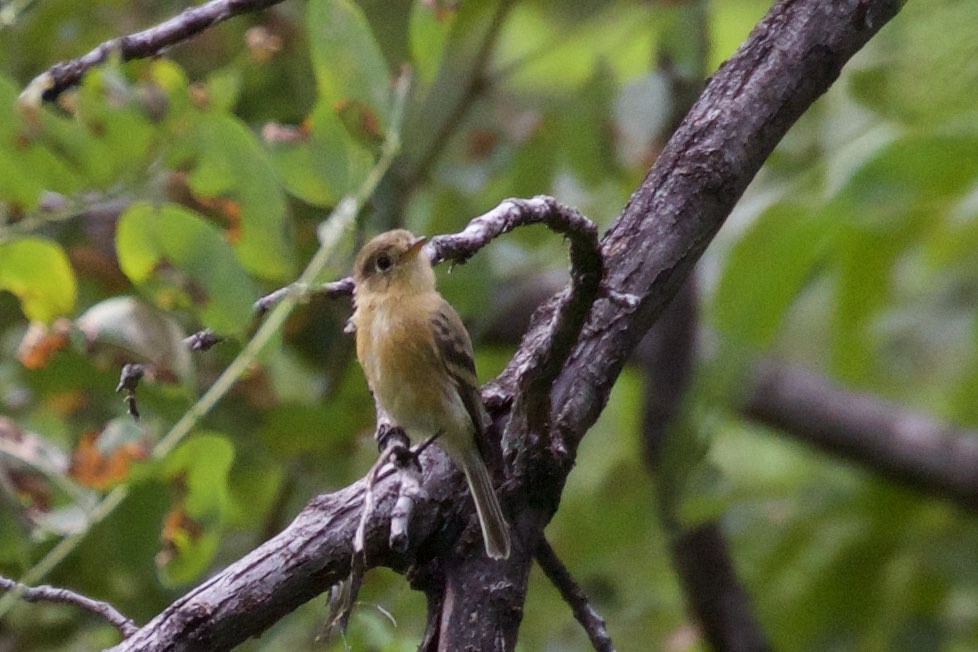Buff-breasted Flycatcher
A species of Empidonax flycatchers Scientific name : Empidonax fulvifrons Genus : Empidonax flycatchers
Buff-breasted Flycatcher, A species of Empidonax flycatchers
Botanical name: Empidonax fulvifrons
Genus: Empidonax flycatchers
Content
Description General Info
Description
The buff-breasted flycatcher (Empidonax fulvifrons) is a small insectivorous bird. It is the smallest Empidonax flycatcher, typically ranging from 11.5 to 13 cm (4.5 to 5 in) in size. Adults have olive gray upper bodies, darker coloration on the wings and tail, conspicuous white eye rings, white wing bars, small bills, and short tails. The breast of this species is distinctive, washed with a strong orange-buff color. Their preferred breeding habitat is scrub and open woodlands. They usually make a cup nest in the forks of trees. Females usually lay two eggs at a time. The range of the buff-breasted flycatcher extends from extreme southeastern Arizona in the United States through Mexico to southern Honduras. These birds are partial migrants, retreating from their northern breeding areas in the United States and northern Mexico for the winter. To feed, they often wait on an open perch of a shrub or low branch of a tree and fly out to catch insects in flight. They also sometimes pick insects from foliage while hovering. The song is an alternating versed PIdew, piDEW. The call is a loud dry pit. 
Size
13 cm (5 in)
Life Expectancy
2 years
Nest Placement
Tree
Feeding Habits
Buff-breasted Flycatcher primarily consumes insects, capturing them mid-flight after short sallies from perches. Habitually, buff-breasted Flycatcher hunts from tree perches, often near the ground, and typically returns to the same spot post-capture. Buff-breasted Flycatcher's diet includes ants, wasps, beetles, grasshoppers, moths, butterflies, damselflies, and spiders.
Habitat
Buff-breasted Flycatcher's habitat includes arid pine-oak forests within mountain canyons, often by water like creeks. It thrives in lower canyon elevations from 2,000 to 9,350 feet, preferring areas with diverse vegetation such as pinyon and Chihuahuan pines, as well as hardwoods. It also occupies oak areas and adapts to riparian zones and thorn scrubs in winter.
Nest Behavior
During nest building and egg-laying, buff-breasted Flycatcher exhibit meticulous construction followed by a discrete laying pattern. Females weave the nests and both parents partake in caring for the progeny, ensuring warmth and protection for the eggs and eventual chicks.
Nest Characteristics
Buff-breasted Flycatcher build nests on mature tree branches, approximately 25 feet high, often adjacent to the trunk and under a sheltering branch. They craft oval cup nests using fine roots, grasses, and leaves, adding exterior decoration of feathers, lichen, and bark secured with spiderweb. Approximate dimensions: 3.4 inches wide, 2.4 inches tall, with an interior cup 1.7 inches wide and 1.5 inches deep.
Dite type
Insectivorous
General Info
Feeding Habits
Bird food type
Bird Feeder Type

Small Tube Feeder

Platform
Sounds
Call
Recording location: Mexico
Behavior
Buff-breasted Flycatcher exhibit a striking blend of territorial aggression and cooperative behaviors. They are known for assertively establishing and defending territories upon their return in late March or mid-April. During mornings, males sing and engage in territorial disputes with neighbors through chasing, even confronting species larger than themselves. Their territories usually cover canyon floors and vary in width. Pair formation sees both sexes participating in the aggressive defense of their nesting area. Courtship involves males recommending nest sites through suggestive posturing and females finally choosing the location with a unique crouching and calling display. Nest construction is female-driven but is under the close supervision of males. Incubation and rearing responsibilities are shared by both partners. Social monogamy is the norm, yet instances of polygyny have been recorded. Post-fledging, family units tend to stick together for several weeks, and outside the breeding season, buff-breasted Flycatcher are typically solitary.
Species Status
Not globally threatened.
Scientific Classification
Phylum
Chordates Class
Birds Order
Perching birds Family
Tyrant flycatchers Genus
Empidonax flycatchers Species
Buff-breasted Flycatcher 